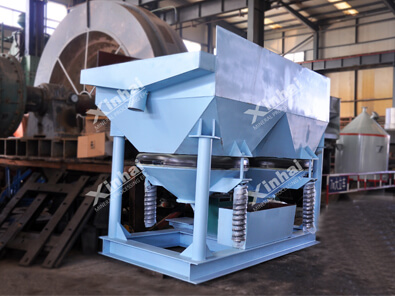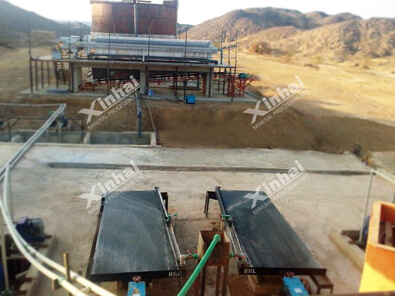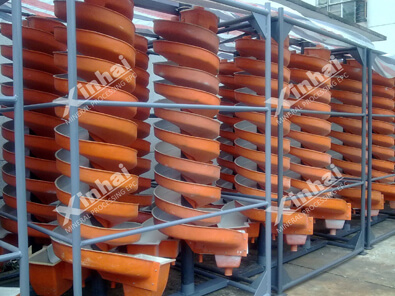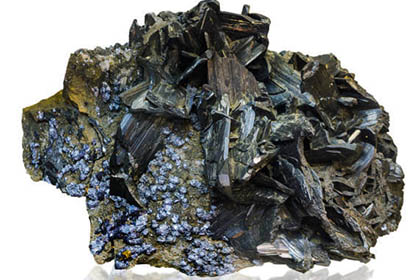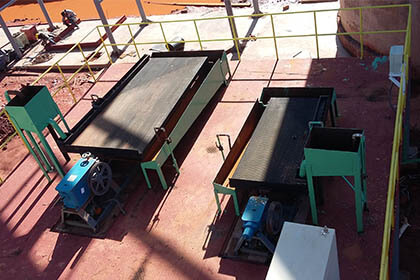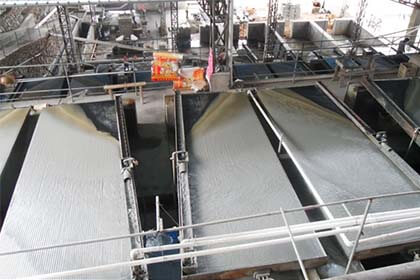The Beginner's Guide to Gravity Separation in 2024
 Chileen Gao
Chileen Gao
 Nov 28, 2022
Nov 28, 2022
 3084
3084
If you want to know more details about equipment, solutions, etc, please click the button below for free consultation, or leave your requirements!

(shaking table for gravity separation processing)
There are extremely rich mineral resources in nature. Mineral processing is the process of separating useful minerals and gangue minerals through various separation methods and equipment according to the difference in physical or chemical properties of ore.
Depending on the type of ore and the requirements for the final product, different separation methods can be adopted in practice. Commonly used separation methods include gravity separation, magnetic separation and flotation separation.
This article focuses on the gravity separation method, including the definition, basic principles, classification, advantages and application of the gravity separation method, and the commonly used equipment.
01What Is the Gravity Separation?
BackDifferent minerals have different densities and properties. When mineral particles of different sizes and densities move in a flowing medium, their state of motion is different.
Gravity separation is due to the difference in density between mineral particles, and they are subjected to different gravity, fluid power and other mechanical forces in the moving medium and present different motion states, so as to realize the process of separating mineral particles.
Basic Principle of Gravity Separation
The essence of gravity separation is the three basic processes of loosening, layering and separation.
1. Loosening
The materials in the separating process are pushed and dispersed in the moving medium due to the action of gravity, fluid power and other mechanical forces.
2. Layering
After the mineral particles are dispersed, due to the difference in their density and particle size, there will be different movement trajectories in the sorting equipment, and at this time the mineral particles will be layered and transferred.
3. Separation
The delamination of the mineral particles are transported by the moving medium to achieve the result of separation.
In practice, the three processes of loosening, layering and separation occur almost simultaneously. But loosening is the premise, which is the condition for the layering and separation of mineral particles, layering is the intermediate process, and separation is the purpose and result of loosening and layering.
02Classification of the Gravity Separation
Back
According to its basic principle, gravity separation can be divided into two types: separating process by particle size and separating process by density.
1.Separating process by particle size.
It can be divided into two types: classification and mineral washing.

(hydrocyclone for mineral classification)
(1) Classification
Classification can be divided into hydraulic classification and wind classification according to the different media. But in the separation process, the most commonly used is hydraulic classification. Here mainly introduces hydraulic classification.
Hydraulic classification refers to the process by which mineral particles in different moving media, according to their different sedimentation speeds, can divide mineral particles of wide particle size into narrow particle size.
The process of hydraulic classification and screening are somewhat similar. But there are fundamental differences.
Hydraulic classification is according to the sedimentation rate of mineral particles to classify it. The density and even shape of mineral particles will have an impact on the classification. It is generally used to process ore particles less than 2-3 mm, and the processing efficiency is high; Screening is strictly according to the particle size of mineral particles grading, generally used to process materials larger than 2-3 mm, and its processing efficiency is also lower than hydraulic classification.
(2) Mineral washing
Mineral washing is generally suitable for ore that is bound by clay. It refers to the method of separating and removing clay wrapped in a mixture of useful minerals. In essence, it is also a re-separation process that separates the mineral particle size.
Mineral washing mainly includes two processes: the crushing and dispersion of clay, and the separation of useful minerals and clay.
Crushing and dispersing of clay refers to the process of dispersing clay that is mixed with useful minerals by soaking and rinsing with water, or mechanical stirring.
The separation of useful minerals and clay refers to the separation of mineral sludge from clay by means such as hydraulic classification.
2. Separating the process by density.
It can be divided into jigging separation, shaking table separation, chute separation and heavy media separation.
(1) Jigging separation
Jigging separation refers to the process of using a flow of vertical alternating media (usually water or air) caused by strong vibrations to stratify mineral particles, according to relative density, and collect light and heavy minerals separately through appropriate methods to achieve the purpose of separation. This method is usually used to process coarse-grained ore with large density differences..
Jiggering separation can be divided into hydraulic jigging, wind jigging and heavy media jigging according to the different media used. At present, hydraulic jigging is commonly used in mineral processing plants.
(2) Shaking table separation
The process of separation on a shaking table takes place on a wide inclined bed. And the water fed by the sink flows to the inclined bed surface and is covered to form a thin layer of uniform beveled water.
At this time, the slurry is fed into the bed surface of reciprocating rocking, and the mineral particles will be layered according to density under the action of gravity, water flow force and mechanical force of bed shaking.
At the same time, mineral particles of different particle sizes move laterally and longitudinally along the inclined bed surface under the action of various forces.
Due to the different particle density, its movement trajectory is also different. Finally, the ore grains of different densities are distributed in a fan shape on the bed surface and thus separated.
(3) Chute separation

(spiral-chute-for-gravity-separation-processing)
Chute separation refers to the method of separating mineral particles in different states of motion in the water flow flowing along the inclined plane.
In the chute, mineral particles of different densities are layered by a combination of gravity, water flow and friction with the bottom of the chute.
The result of stratification is that dense mineral particles are concentrated in the lower layer, moving forward along the trough at a lower speed, sending out the trough at the same time as feeding the ore, or remaining at the bottom of the trough; Mineral particles with low density are distributed in the upper layers and carried away by the current at a large speed.
In this way, mineral particles of different densities are separated in the chute.
(4) Heavy media separation
Heavy media separation refers to the mineral processing method in which mineral particles are separated according to density in a medium with a density greater than water.
The principle of heavy media separation is Archimedes' law. That is, the object will be cared for in the medium, and the magnitude of the buoyancy force is equal to the weight of the same volume medium discharged by the object.
Suppose there are two kinds of minerals, light and heavy, the density of light minerals is ρ1, the density of heavy minerals ρ2, and the density ρ of heavy media should be between light and heavy minerals, that is, ρ1<ρ<ρ2. In such a medium, separating can be carried out efficiently.
03The Advantages and Application of the Gravity Separation
Back1. Advantages
Compared with other separation methods, gravity separation has the following advantages:
(1) The gravity separation method has a wide range of applications, and the particle size range of the material that can be processed is wide, up to several hundred millimeters in thickness and up to 0.01 mm in fine;
(2) The structure of the resorting equipment is simple, and the operation is convenient and reliable; Low production cost and cost-effective;
(3) The products treated by the gravity separation method are easy to dehydrate and have less pollution to the environment.
2. Application
The gravity separation method is widely used in the separating of precious metal ores (gold, platinum, etc.), rare metal ores (tungsten, tin, titanium, zirconium, niobium, tantalum, etc.), ferrous metal ores (iron, manganese, etc.) and coal. In addition to this, it can also be used for pre-separation of non-ferrous metal ores (lead, zinc, etc.) and processing of scrap metal ores (diamond, asbestos, etc.).
In terms of processing material size, the gravity separation method can process materials as small as 0.01 mm, such as tungsten ore, tin ore sludge, and can also process materials as large as 200 mm, such as coal.
046 Commonly Used Gravity Separation Equipment
BackBecause of the many advantages of the gravity separation method, and its wide applicability, it has been paid more and more attention at home and abroad in recent years. And a series of efficient and economical equipment have been produced in the field . Here are some of the most widely used gravity separation devices:
1.Diaphragm jig
(1) Working principle
The diaphragm jig is divided into two types: left and right jig, and its sieve is fixed.
Diaphragm jigs can be used to separate both fine-grained and coarse materials. The maximum feed grain size is 6-8mm. However, in some special cases of mineral sand, the maximum feed ore particle size can reach 12mm.
(2) Scope of application
It is suitable for separating gold, iron, tin, tungsten, titanium, coal and other minerals, especially in the field of manganese ore separation has been widely used.
2. Centrifugal separator

(centrifugal separator for gravity separation)
(1) Working principle
The centrifugal separator is also a gravity separation equipment. It generates a large centrifugal force through high-speed rotation, intensifies the reseparation process, and enables the efficient recovery of fine ore grains.
(2) Scope of application
Centrifugal separators are suitable for the recovery of monomer gold in vein gold ore, and can also be widely used to recover monomer gold in other metal minerals.
3. Sawtooth wave jig

(sawtooth wave jig for gravity separation)
The Sawtooth wave jig is one of the modern separating equipment, which has been improved on the basis of the traditional jig.
(1) Working principle
Traditional jigs are mostly eccentric driven by circumferential eccentricities, and their jig pulsation curves are sinusoidal waveforms. Since the rising and falling water flow speed and time generated by the diaphragm movement are basically the same, it is not conducive to the stratification of ore particles according to the proportion gravity, which affects the selection efficiency of the equipment.
The pulsation curve of the sagging wave jig is zigzag, which makes the upward flow faster than the downward flow. It overcomes the shortcomings of traditional jigs, allowing heavy proportions of ore grains to settle adequately. This greatly improves the sorting capacity of the equipment and the recovery rate of minerals.
(2) Scope of application
Sawtooth wave jig are widely used in the selection of minerals such as placer gold, iron, tin, titanium, coal and so on, especially in the field of mineral processing of barite.
4. XS shaking table

(shaking table for gravity separation)
(1) Working principle
XS shaker is mainly composed of bedhead, motor, sloper, bed surface, mining tank, sink, back strip and lubrication system handle.
The reciprocating movement of this shaking table is achieved by means of a crank linkage drive. The motor drives the crankshaft to rotate through the belt, and the joystick moves up and down.
When the joystick moves downward, the toggle plate pushes the rear axle and the reciprocating rod to move back, the spring is compressed, and the bed surface will also do backward movement because the bed surface is connected to the linkage seat and the reciprocating bar; Prevent the bed surface from moving forward when the stick moves upwards.
(2) Scope of application
XS shaking table is officially used in the separation of tungsten, tin, gold, tantalum, niobium and other rare and precious metal ores, and can also be used for iron, manganese and coal ore processing.
5.XY shaking table
(1) Device characteristics
The XY shaking table works similarly to the XS shaking table. It has some other features:
(1) The shaking bed surface is flat, strong and durable, not easy to deform;Easy for local repair; Good corrosion resistance;
(2) The bedside device has fewer vulnerable parts and is not easy to leak oil;
(3) The bedside movement is asymmetrical, has a wide adjustment range, and can be applied to different feed particle sizes.
(2) Scope of application
XY shaker is suitable for the separating of non-ferrous metals such as tungsten, lead, tin, gold, ferrous metals and rare earths.
6. BLL FRP spiral chute

(spiral chute for gravity separation)
(1) Working principle
In the spiral chute, the mineral sand is transported by a sand pump to the two feed ports at the top of the spiral, and water is added to adjust the slurry concentration. In the process of swirling down from a high place, the slurry will produce a centrifugal force, so that the mineral particles with different densities and forces will produce different states of motion, and the minerals will be separated.
The concentrate flows into the concentrate hopper, and the tailings flow into the tailings hopper to separate the minerals.
(2) Scope of application
FRP spiral chute is suitable for sorting tungsten, lead, tin, gold, tantalum, niobium, coal, rutile, zircon and other fine-grained minerals and minerals with small specific gravity.
05Summary
BackThis article briefly understands the gravity separation method by introducing the concept, basic principles, classification, advantages and applications of the gravity separation method, as well as several main gravity separation equipment. Up to now, new technologies and new equipment for gravity separation continue to appear, and the gravity separation process has taken on a new look. Welcome to click the chat button to learn more about gravity separation.
 +86 18716000713
+86 18716000713 xlyin@xinhaimining.net
xlyin@xinhaimining.net




 Message
Message Chat Now
Chat Now


